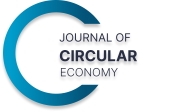What Can We Learn From the Bankruptcy of Renewcell? Some Limitations of Business-Case-Based Circular Transition
Abstract
Circular start-ups are vectors of hope for a circular transition. But what does a circular champion’s bankruptcy tell us? That a structural barrier to the circular transition is the total dependence on the ability of circular businesses to be profitable.
References
Circle Economy (2024). The circularity gap report 2024. Circle Economy and Deloitte. https://www.circularity-gap.world/2024
Dewick, P., de Mello, A. M., Sarkis, J., & Donkor, F. K. (2022). The puzzle of the informal economy and the circular economy. Resources, Conservation and Recycling, 187, 106602. https://doi.org/https://doi.org/10.1016/j.resconrec.2022.106602
Grafström, J., & Aasma, S. (2021). Breaking circular economy barriers. Journal of Cleaner
Production, 292, 126002. https://doi.org/https://doi.org/10.1016/j.jclepro.2021.126002
Henry, M., & Kirchherr, J. (2020). Circular start-ups: Five business model archetypes as frontrunners of circular disruption In T. Tudor & C. J. Dutra (Eds.), The Routledge Handbook of Waste, Resources and the Circular Economy. Routledge.
Henry, M., Kirchherr, J., Raven, R., & Hekkert, M. (2024). Bottom-up dynamics in circular innovation systems: The perspective of circular start-ups. Journal of Industrial Ecology, 28(2), 320-338. https://doi.org/https://doi.org/10.1111/jiec.13468
Hina, M., Chauhan, C., Kaur, P., Kraus, S., & Dhir, A. (2022). Drivers and barriers of circular economy business models: Where we are now, and where we are heading. Journal of Cleaner Production, 333, 130049. https://doi.org/https://doi.org/10.1016/j.jclepro.2021.130049
Hobson, K. (2020a). From circular consumers to carriers of (unsustainable) practices: Socio-spatial transformations in the Circular City. Urban Geography, 41(6), 907-910. https://doi.org/10.1080/02723638.2020.1786329
Hobson, K. (2020b). The limits of the loops: Critical environmental politics and the Circular Economy. Environmental Politics, 1-19. https://doi.org/https://doi.org/10.1080/09644016.2020.1816052
Kanda, W., Klofsten, M., Bienkowska, D., Henry, M., & Hjelm, O. (2024). Challenges of circular new ventures: An empirical analysis of 70 cases. Journal of Cleaner Production, 442, 141103. https://doi.org/https://doi.org/10.1016/j.jclepro.2024.141103
Närvänen, E., Mattila, M., & Mesiranta, N. (2021). Institutional work in food waste reduction: Startups’ role in moving towards a circular economy. Industrial Marketing Management, 93, 605-616. https://doi.org/https://doi.org/10.1016/j.indmarman.2020.08.009
Rask, N. (2022). An intersectional reading of circular economy policies: Towards just and sufficiency driven sustainabilities. Local Environment, 1-17. https://doi.org/10.1080/13549839.2022.2040467
Stowell, A. F., & Corvellec, H. (2023). Circular Economy practices will not automatically phase out the linear economy. Future Earth. https://futureearth.org/2023/02/22/circular-economypractices-will-not-automatically-phase-out-the-linear-economy/
Werning, J. P., & Spinler, S. (2020). Transition to circular economy on firm level: Barrier identification and prioritization along the value chain. Journal of Cleaner Production, 245, 118609. https://doi.org/https://doi.org/10.1016/j.jclepro.2019.118609
How to Cite This Article
Corvellec, H., & Stowell, A. F. (2024). What can we learn from the bankruptcy of Renewcell? Some limitations of business-case-based circular transition. Journal of Circular Economy, 2(1). https://doi.org/10.55845/tfhb2038
Copyright
Open Access: This article is licensed under a Creative Commons Attribution 4.0 International License, which permits use, sharing, adaptation, distribution and reproduction in any medium or format, as long as you give appropriate credit to the original author(s) and the source, provide a link to the Creative Commons licence, and indicate if changes were made. The images or other third-party material in this article are included in the article’s Creative Commons licence, unless indicated otherwise in a credit line to the material. If material is not included in the article’s Creative Commons licence and your intended use is not permitted by statutory regulation or exceeds the permitted use, you will need to obtain permission directly from the copyright holder. To view a copy of this licence, visit http://creativecommons.org/licenses/by/4.0/.
License
Under a Creative Commons license
Author Notes
Hervé Corvellec [1]*, Alison F. Stowell [2]
- [1] Lund University, Sweden
- [2] University of Lancaster, UK
- * Corresponding author: [email protected]
Published Details: Received: 13.03.2024 / Accepted: 18.04.2024 / Published: 04.06.2024
